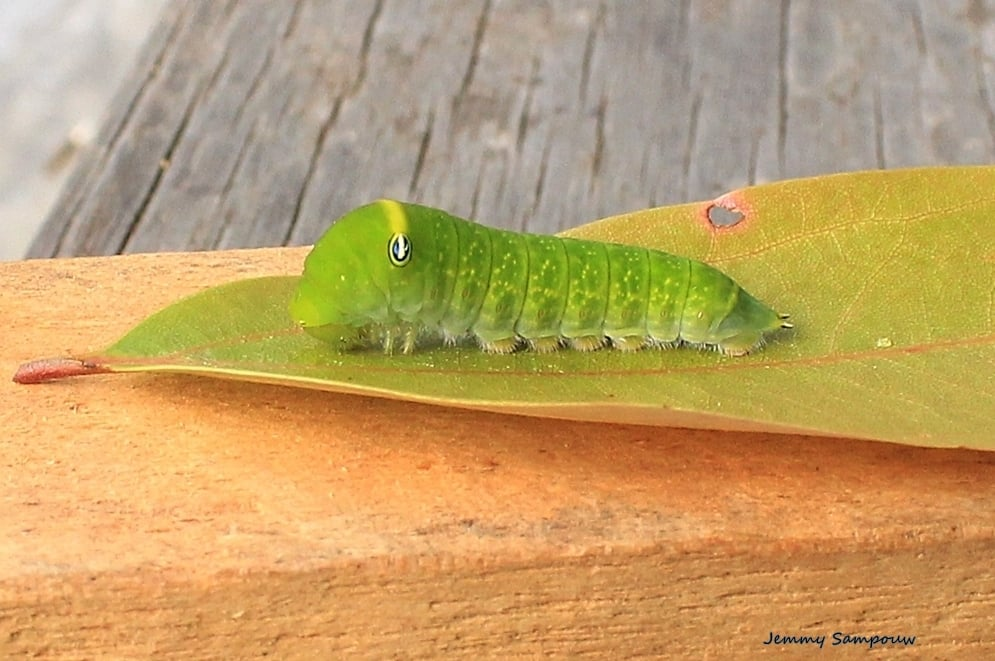A few of the butterflies in the genus Graphium show a large amount of bright cerulean blue on their wings, and are nicknamed Bluebottles.
Graphium anthedon has been called Wallace's Bluebottle in English. It is found on a few islands south of Asia, especially Sunda and Sulawesi. Human activity there has historically been sparse and not included a great amount of science, so there is some confusion about anthedon in the best documents available online. Some have divided anthedon into subspecies; some have confused subspecies names with different species; and it's not altogether clear whether anthedon is different enough from G. sarpedon to be a separate species.
Photo from Wikimedia Commons. It is one of the Swallowtail species whose hind wings may show little points, but not real "tails."
Photo from Abcdefgewing. The undersides of the wings often fade to dark brown or gray and white, and always show some markings in bright red.
Photo by Desertnaturalist. In some Swallowtail species the female tends to look more faded than the male, and this one's hind section appears to be folded around a new young leaf, but this kind of question has not been clearly answered for Graphium anthedon. It looks like a female laying an egg.
Photo by Mroseup. Is damage to the right hind wing a factor in allowing this butterfly to be photographed in flight? They are described as extremely hard to photograph except in groups of males at puddles.
Females average larger than males, but precise meausrements are not available. Photos of individuals in human hands suggest that they are about the size of Battus philenor. The blue color appears to be iridescent, showing much brighter and darker in some lights, but may also fade with time.
A web page set up by someone who clearly lacks native fluency in English suggests that this butterfly may be considered a pest. This is improbable in nature, because nature limits butterfly populations to prevent destruction of host plants. They aren't pests in the sense that they endanger plant species. However, greedy farmers who want to "monocrop" a plant may not realize that the plant exists in a symbiotic relationship with a butterfly species, and this is common with the Swallowtails. A caterpillar may strip one branch, arousing fears, but the adult butterfly compensates the plant by pollinating it and, in fact, the host plants of many Swallowtails can't survive without these "pests." Americans who like pawpaw fruit and wanted to protect their trees from defoliation by Zebra Swallowtails found that eliminating the butterflies eliminated the fruit.
Subspecies names have included coelius, crudum or crudus, dodingensis, halesus, miletus, milon, milonides, moluccensis, monticolus, and sulaensis. Funet has links to early discussions of these subspecies, but Funet links were not working when this post was written. Generally subspecies seem to have been distinguished by the width and continuity of the band of turquoise blue across each wing. Little information about the subspecies is available but a photo of dodingensis suggests that it may be distinguished by having unusually pale or fast-fading underwings.
As usual with Swallowtails, early names reflected the tradition of naming Swallowtails after characters in literature. Anthedon was the legendary founder of a town in Greece, believed to be a human but part of a family that at least shared the names of lesser deities; or, the town may have practiced ancestor worship, but quickly "progressed" to worshipping more powerful city-states' gods.
Sarpedon was one of the leaders on the Trojan side in the Iliad. He was said to be a grandson of Bellerophon, whose daughter was one of the many pretty girls said to have been impregnated by Zeus.
Coelius means "of the sky" and may have been chosen to describe the butterfly's color, but it was also the name of several people in ancient Rome, including Coelius or Caelius Sedulius, an early Christian poet.
Crudus and crudum are the Latin words from which "crude" derived. They generally meant raw, unripe, unprepared; as descriptions of humans, rough, unskilled, uneducated; as descriptions of meat, uncooked, bloody, which might describe the red markings on the butterfly's wings.
Halesus was the name of a few minor characters in Greek literature. One of them was a companion, some say a son, of Agamemnon.
Miletus was the name of a town in what is now Turkey, near Ephesus. It is mentioned in the Bible as well as in Greek and Roman literature. The town was probably named after a man, but any stories about him have been lost. Later some people were named after the town.
Milon, or Milo or Milos, was a star athlete in ancient Greece. In Greek the three different versions of the name were used to indicate where the name fitted into a sentence. Milonides means "son of Milo."
Monticolus means "of the low hills."
Dodinga, Molucca, and Sula are places within this butterfly's range.
The species is mentioned, sometimes with photos, on the longish lists of butterflies seen on walking tours in this region. The blog post below gives no information about anthedon but includes its photo in a long, rich gallery of poorly documented butterfly species, big and small, colorful and drab, all overshadowed by the eye-catching Birdwings and all threatened by human "development."
Because the upper wings are so showy, this butterfly often appears in pop art. A drawing by Adolphe Millot, where a specimen of anthedon appears on the right edge, about halfway up the page, has entered the public domain and been used as a model for embroidery and painting. Some information about the man and the butterflies is found at the page linked below, though little information about anthedon is shown.
If your focus is on living butterflies you may be put off by jewelry that attaches butterfly wings to gemstones...
The life cycle seems not to be thoroughly researched yet. Caterpillars are said to eat leaves of plants in the genus Cinnamomum.





No comments:
Post a Comment